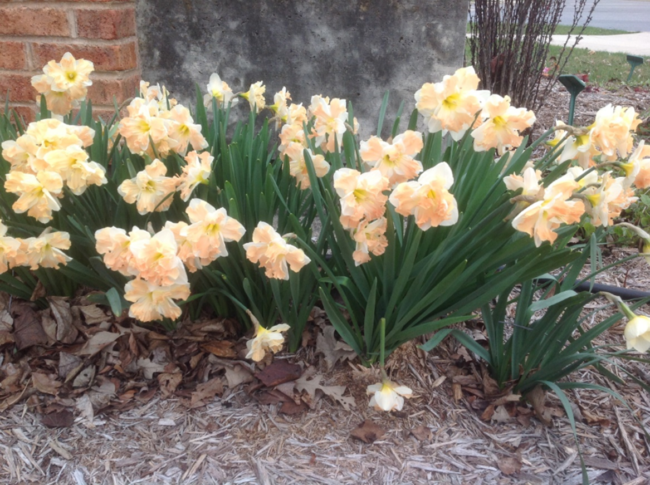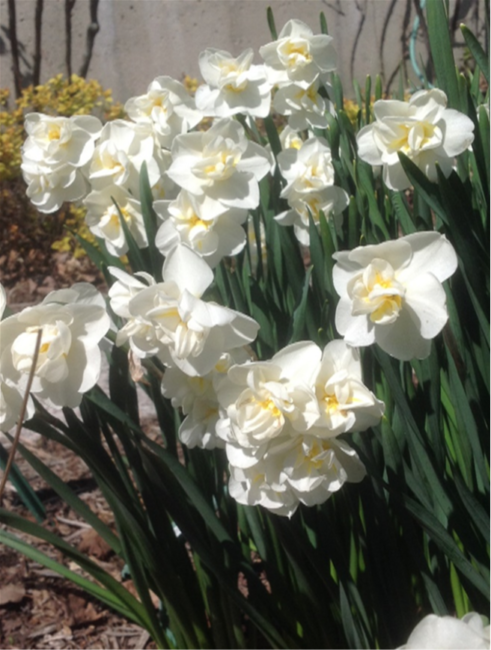It’s a great time of year.
Bulbs, native spring wildflowers and various trees and shrubs are all blooming! Here are some of the highlights over the past three to four weeks.
Bulbs: We have a couple of late-season daffodils still blooming. ‘Palmares’ is a member of Division 11 of the Narcissus genus. That division has split coronas (the flower ‘cup’ or ‘trumpet’ in daffodils) which are more than half the length of the perianth. In some other divisions the corona is shorter. The perianth consists of sepals and petals. In many plants, sepals are leaf-like structures surrounding the base of the flower. But in daffodils, they are absent, and instead of petals, the petal-like colored structures are called ‘tepals’ (interestingly, an anagram of petals!). The frilly corona is a beautiful soft peachy color that holds up well all during bloom. The second late season daffodil we have is ‘Winston Churchill’ which has multiple flowers per stem and is wonderfully fragrant. It is in Division 4 – a Double “One or more flowers to a stem, with doubling of the perianth segments or the Corona or both”. It is a lovely and reliable bloomer. We also still have Anemone blanda blooming, the Grecian windflower. I have seen several small bees visiting it. Windflower grows from a fall-planted tuber.



We also still have Anemone blanda blooming, the Grecian windflower. I have seen several small bees visiting it. Windflower grows from a fall-planted tuber.

Native Wisconsin Spring Wildflowers Two native plants that grow in shade and are blooming now are the beauteous Virginia bluebells and rue anemone. Virginia bluebells’ flowers Virginia Bluebells, Mertensia virginica – Wisconsin Horticulture have a spectrum of color that the blossoms go through, starting with pinky lavender buds and ending with sky blue fully expanded bell-like flowers. Bumble bees, long-tongued bees and butterflies really love them. They will start to seed when they are happy in an area, so they can spread into colonies. However, they go dormant around the end of May to early June, so you can plant around them. Then other plants can take over once the bluebells have gone.


Rue anemone, a low-growing wildflower for shade, also spreads by seed, but the dainty foliage remains all season. Their delicate white flowers bloom for a relatively long period. They grow from tiny tubers in a little cluster underground. If you are interested in learning more about Wisconsin spring wildflowers, I have a Green Thumb Gardening class on that subject that I hold in early spring annually. Subscribe to this blog to get notified when it is time to register.

Non-native perennials: Our rock garden has a number of species in bloom right now. we have a tufted phlox plant that looks similar to moss or creeping phlox, but does not spread much. This one has a magenta flower, and is called ‘Crackerjack’. Another spring blooming, low-growing groundcover is a speedwell (Veronica) called ‘Georgia Blue’. It has a long bloom time and the leaves turn bronze in fall.

Another spring blooming, low-growing groundcover in the rock garden is a speedwell (Veronica) called ‘Georgia Blue’. It has a long bloom time and the leaves turn bronze in fall. It can take regular garden soil as well as rock garden soil. It just needs full to part sun and good drainage.

There are many cultivars of early-blooming dwarf bearded iris available. They are generally 4-8″ tall and bloom a few weeks ahead of the tall blooming bearded iris. They need sun and good drainage, and will grow in average soil as well as in rock garden settings. This one has the amusing name ‘Dinky Circus’.

Shrubs: The forsythia is an iconic harbinger of spring. I use forsythia as a time clock to let people know that it is time to apply crabgrass preventer to lawns if they have a crabgrass issue. I also like them because they are great for early season pollinators, and the bright yellow color is so beautiful. This cultivar, Golden Peep™ is a dwarf, and doesn’t get much taller than 20”. Most forsythias are large, sprawl plants. This one is petite, but does spread unless it is pruned. It also has flowers closely spaced and larger than many cultivars, so it is visually dense.


Trees: The earliest bloomer in the Teaching Garden is the corneliancherry dogwood. It blooms in early April in a cloud of tiny, clustered yellow flowers. They dropped their petals a couple weeks ago. This is a nice small scale tree with shreddy bark is light beige and peach. The flowers, after pollination, produce grape-size cherry-colored fruits in summer. Actually, a lot of fruits that hit the ground germinate–at least for our cultivar—so we have a lot of seedlings to pull. The fruits are edible, but pretty sour and astringent. They can be used for syrups and preserves. To harvest, it is best to get fallen ones (before they rot and the seeds germinate!) that are dark purple red and on the ground to get the most sugar content. There is a rather large seed inside. We also have a variegated cultivar of corneliancherry dogwood that is more narrow and upright, and it fruits less, but still has a nice yellow spring bloom.


The second earliest bloomer is our native serviceberry (Amelanchier spp). They have already dropped their petals for the season as well. There are a number of species and cultivars available and they all have smooth gray bark, a graceful shape, and clusters of white flowers. They go on to produce tasty berries for the birds in summer, and develop beautiful fall color in shades of yellow, orange, rust or red.

Our native redbud is in full bloom now, and covered with tiny, orchid-colored, edible flowers. This small-scale tree is marginally hardy in our area, so the cultivar to get is called ‘Columbus Strain’, since it is the most cold-tolerant. The tree has shreddy pinky-beige and peach bark and a graceful habit. The edible flowers taste slightly peppery. Sprinkle a few in a salad for a pop of color.


Come visit us at the Teaching Garden https://dane.extension.wisc.edu/horticulture/teaching-garden/ this spring or later in the growing season!




